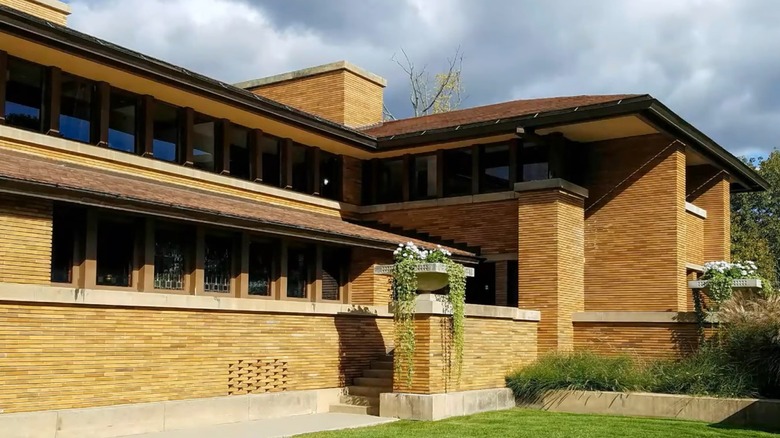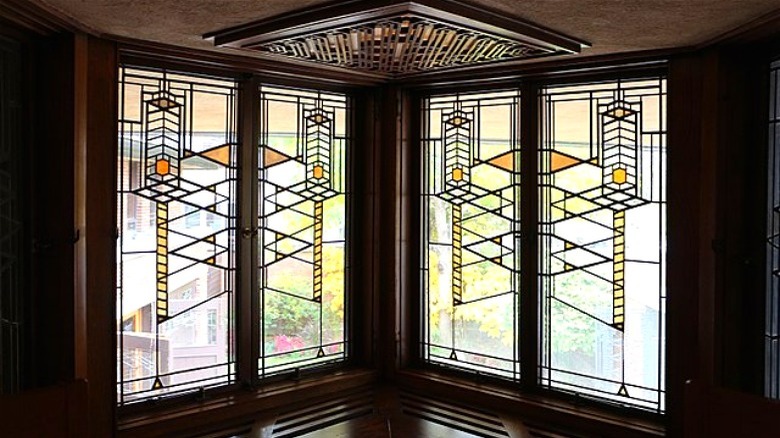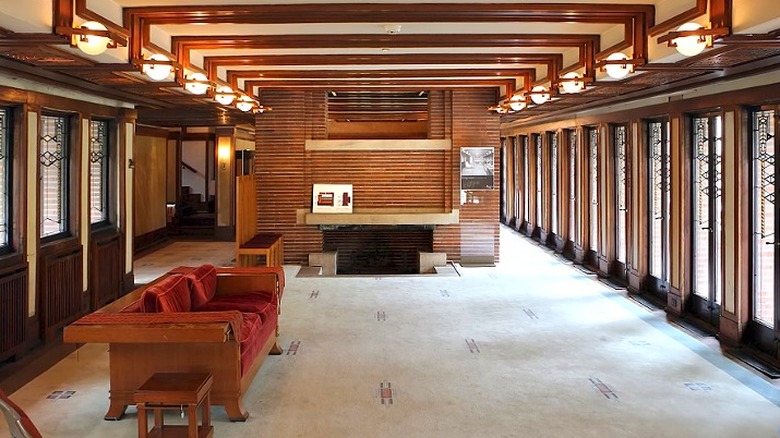The Iconic Window Style That Sets Prairie House Architecture Apart
In 1893, a group of forward-thinking architects in Chicago, led by visionary Frank Lloyd Wright, developed America's first truly home-grown architectural style, one that reflected the broad, flat plains of the Midwest. Dubbing it Prairie style, sometimes called Prairie School, it took its influence not only from the local landscape but also from a fatigue of the overdecorated, fussy homes of the late Victorian era.
The distinct, defining characteristics of Prairie style weren't found anywhere else in architecture at the time. Wide, low-hipped roofs, clean angular lines, and built-in furniture matched with natural elements and materials used throughout the home. Aiming to bring the outdoors inside, many homes had specific motifs relating to the environment, like plants, leaves, or ornamental shapes consistently used throughout in wooden carvings, furniture design, or featured glass pieces.
But most importantly, where Victorian homes tended to be dark with closed-off rooms, Prairie-style homes embraced the earliest forms of open-plan living, with light, bright interiors and rooms that flowed from one to another.
That interior light was provided by one of Prairie style's most defining features: the windows. Banks of windows were hung side by side, horizontally aligned, all sharing the same heading trim. Sometimes taking up an entire wall, the windows created bright spaces that allowed views of nature to become part of the interior décor. The window panes were separated by mullions, or dividers, and in higher-end homes were often embellished with multicolored, geometrically shaped stained-glass patterns.
The glass itself is a signature of the Prairie style
The elaborate geometric designs are one of the defining features of Prairie style, whether a simple pattern of multicolored squares, or leaded art glass featuring intricately laid-out patterns. Unlike earlier stained-glass windows, which often featured rounded natural motifs, often with frosted or tinted glass, Prairie-style windows tended toward angular lines and shapes, with sections of clear glass interspersed with panes in translucent, sometimes iridescent color. With art glass, the colors created a gentle filtration of the light in the home — Frank Lloyd Wright often referred to them as "light screens." The geometric patterns created a balance between letting the residents connect with nature, yet obscuring the inhabitants enough to provide a modicum of privacy from the outside world.
Not all Prairie-style windows were colored or elaborate. However, even the most basic windows contained a unique grid, the way the windows are divided. In Prairie style, basic windows usually contained a large pane in the middle, surrounded by four smaller squares in the corners. That allowed clearer viewing out to the natural surroundings through the larger pane. In double-hung windows, the top and bottom sashes of a window didn't have to match; a bottom sash could have no mullions or the top and bottom could be reflections of each other. However, whether double-hung or casement windows — ones that swing out on a side hinge — the grid patterns in a wall of Prairie-style windows would all have been consistent.
Incredible examples of Prairie style still exist
No words can fully describe the experience of seeing Prairie-style windows in person, in the rooms they were originally built for and their natural surroundings. Luckily, there are many incredibly well-preserved homes you can tour that allow visitors to really see the magic and beauty of the windows and the light.
One of the biggest showstoppers on a Prairie School tour is the Frederick C. Robie House by Frank Lloyd Wright in Chicago, Illinois. Considered one of the ultimate expressions of the Prairie style, inside, banks of leaded art glass windows and doors throughout the house fill the rooms with soft light, reflecting on the dark wood and decorative earth tones.
Further afield in Buffalo, New York, is the massive Darwin D. Martin House, also built by Wright. The "house" is actually a 1.5-acre estate with a main house and a series of small buildings, many with interconnected walkways. The estate features 16 different art glass motifs, more than any other single property of the era.
Prairie style wasn't limited to homes, and one of the few remaining public or commercial buildings still standing that reflect the style is the Unity Temple connected to the Oak Park Unity Church in Chicago. Passing through a dark hallway, the room opens into a light-filled sanctuary. Unlike the walls of windows in Prairie homes, in this case, 25 leaded art glass skylights rain warm sunlight down to the parishioners below.


